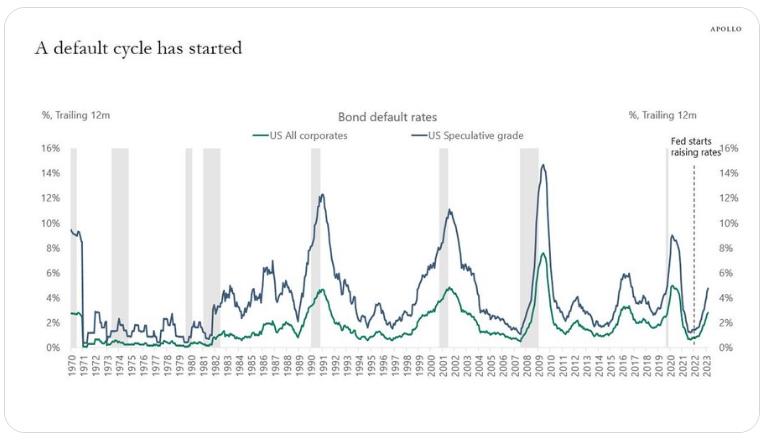
In a recent development, Apollo has sounded the alarm, indicating that a new default cycle is already in motion, and default rates are surging dramatically.
The numbers tell a sobering story. Default rates on all U.S. corporate bonds have experienced a staggering increase, nearly tripling from their lows of around 1% back in 2021. This sharp uptick has occurred as the Federal Reserve initiated a series of rate hikes, pushing the default rate for all U.S. corporate bonds to a notable 3%.
However, the situation is even more concerning for speculative grade bonds, where default rates have catapulted from 1.5% to a striking 5% in just over a year. These figures underscore the growing fragility of the corporate bond market.
The pivotal question that looms is whether the Federal Reserve can defy historical patterns and navigate the economy away from an impending recession. The odds seem increasingly challenging, especially as interest rates continue to climb despite the Fed’s efforts to slow down rate hikes.
The primary driver behind rising interest rates is the exceptionally high levels of deficit spending, leading to the issuance of trillions of U.S. bonds. This surge in deficit spending is taking a toll on corporations.
Adding to the complexity of the situation, a staggering $7.6 trillion of U.S. government debt is set to mature in the next year, as highlighted by Apollo. The management of this colossal debt load is a matter of great interest and concern, whether it involves refinancing or alternative strategies. The repercussions of these decisions could have far-reaching implications for interest rates and the broader financial markets, making it a critical area to monitor closely.
Sources:
Even as the Fed has slowed rate hikes, interest rates are still rising.
This is because deficit spending is so high that trillions of Dollars of US bonds are issued.
Deficit spending is hurting corporations.
Follow us @KobeissiLetter for real time analysis as this develops.
— The Kobeissi Letter (@KobeissiLetter) September 20, 2023
$7.6 trillion of US government debt will mature in the next year, per Apollo: pic.twitter.com/htEogQwA4J
— unusual_whales (@unusual_whales) September 20, 2023